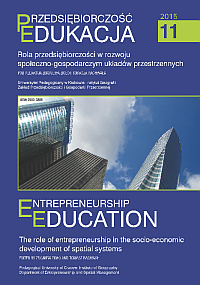Intensification of spa services in Poland following the system transformation period
DOI:
https://doi.org/10.24917/20833296.11.12Keywords:
spa patients, spa resortssystem transformation, tourist infrastructureAbstract
The intention behind this study is to present the general character of the changes affecting Polish sparesorts after 1989. In 2014, 44 localities (or parts thereof), and the Wieliczka salt mine, held the statusof spa resorts while the Lower Silesian Voivodeship was characterised with the greatest concentrationof spa facilities. Referring to the statistical data, reports published by GUS - the National Statistical Office and Ministry of Health, as well as the subject-related bibliography and their own in-situobservations, the authors illustrated the infrastructural condition of the selected spa resorts, andthe use of the same. By the term “infrastructure” the authors understand an accommodation base combined with elements of spa treatment as defined in related legislation. Special attention was paidto sanatorium activities through analysing the changing number of sanatoriums (the most common type of spa treatment facility) and spa hospitals starting from the mid-1990s. Secondly, the changing number of patients visiting particular spa resorts was presented. Have any noticeable quantitive andqualitative changes occurred in Polish spa resorts in connection with the political, economic and social transformations taking place during the last quarter-century? Which of these spas benefitted best from the system transformation period, becoming leaders on the domestic spa market?
References
Chojecka, A. (2011). Lecznictwo uzdrowiskowe elementem kształtującym aktywny wypoczynek i zdrowy styl życia człowieka. W: B. Płonka-Syroka, A. Syroka (red.). Kultura uzdrowiskowa w Europie, t. II. Historia polskiej kultury uzdrowiskowej. Wrocław, 287-295.
Dietl, J. (1858). Uwagi nad zdrojowiskami krajowemi ze względu na ich skuteczność, zastosowanie i urządzenie. cz. I, Kraków, 160.
Florków, R. (1994). Istota, znaczenie i formy leczenia uzdrowiskowego oraz ogólne przeciwwskazania bezwzględne. W: F. Kiryk (red.), Krynica, Kraków, 71.
Golba, J. (2001). Rozwój infrastruktury uzdrowiskowej oraz okołouzdrowiskowej jako podstawa rozwoju miejscowości uzdrowiskowych. W: Turystyka i sport w działalności rządu, samorządów terytorialnych i organizacji pozarządowych. Materiały III Forum Turystyki i Sportu Samorządów Terytorialnych RP, Kraków, 18-19 maja 2001 r., 60-68.
Lisowska, B. (2014) W Polsce powstaną nowe uzdrowiska. Ale kuracjusze nie będą mogli z nich korzystać. Pozyskano z: http://serwisy.gazetaprawna.pl/samorzad/ artykuly/778802,w-polscepowstana- nowe-uzdrowiska-ale-kuracjusze-nie-beda-mogli-z-nich-korzystac.html
Kaleta, A. (2012). Hotelarstwo Spa i Wellness jako rozwojowy produkt przemysłu czasu wolnego – wybrane aspekty. Zarządzanie i Finanse, 1, 361-371.
Prętek, K. (2011). Podstawy prawne funkcjonowania lecznictwa uzdrowiskowego w systemie ochrony zdrowia w Polsce w latach 1918–2005. W: B. Płonka-Syroka, A. Syroka (red.), Kultura uzdrowiskowa w Europie, t. II. Historia polskiej kultury uzdrowiskowej. Wrocław, 187.
Rachwał, T. (2006). Restrukturyzacja technologiczna przedsiębiorstw przemysłowych Polski Południowo- Wschodniej jako czynnik podnoszenia ich konkurencyjności na rynku międzynarodowym. Prace Komisji Geografii Przemysłu Polskiego Towarzystwa Geograficznego, 8, 192-203.
Wołowiec, T. (2002). Problemy finansowo-prawne funkcjonowania rozwoju polskich uzdrowisk. Folia Turistica, 12, 89-99.
Wołowiec, T. (2003). Sposoby rewitalizacji polskich uzdrowisk. Ustawa o gminach uzdrowiskowych i inne formy aktywizacji społeczno-gospodarczej. Folia Turistica, 14, 5-25.
Zioło, Z. (1999). Model funkcjonowania przestrzeni geograficznej jako próba integracji badań geograficznych. W: A. Lisowski (red.), Geografia na przełomie wieków – jedność w różnorodności. Warszawa: Wydział Geografii i Studiów Regionalnych Uniwersytetu Warszawskiego, 122-131.
Zioło, Z. (2011). Funkcjonowanie przedsiębiorstwa w strukturze regionu – zarys modelu. Nierówności społeczne a wzrost gospodarczy. Uwarunkowania sprawnego działania w przedsiębiorstwie i regionie, 20, Rzeszów: Wydawnictwo Uniwersytetu Rzeszowskiego, 26-46.
Downloads
Published
How to Cite
Issue
Section
License
Articles are published under the terms of the Creative Commons License (CC BY-ND 4.0; Attribution– NoDerivs).

